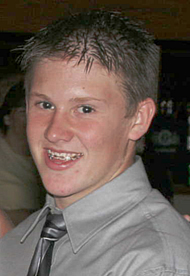Miracle Kids: Cal Livingston
After a Year-Long Journey, This Champ Heads Home
 To say that 17-year-old Cal Livingston is fond of the great outdoors would be an understatement. He grew up riding dirt bikes, jet-skis and snowmobiles, not to mention camping and hunting. And as far as high school sports are concerned, Cal, a Geneseo Central tri-athlete, ate, slept and drank baseball, hockey (his favorite), and football.
To say that 17-year-old Cal Livingston is fond of the great outdoors would be an understatement. He grew up riding dirt bikes, jet-skis and snowmobiles, not to mention camping and hunting. And as far as high school sports are concerned, Cal, a Geneseo Central tri-athlete, ate, slept and drank baseball, hockey (his favorite), and football.
That’s why, in December 2006, when he began experiencing flu-like muscle soreness after a hockey game, no one thought too much of it.
“Like a tough sport, he had mustered his game-strength while admittedly feeling a little under the weather,” his mother, Micki Livingston, said. “He even scored the winning goal.”
But when Cal’s condition worsened, Livingston and her husband, Dave, soon sensed that something more serious was at play. Doctors in Geneseo sent Cal to Golisano Children’s Hospital.
In Rochester, test after test shed little light on the mysterious illness that had struck without warning, and Cal’s health was slipping so fast and his breathing had become so labored that doctors feared it might sap his much-needed strength. To conserve it, he was sedated and placed on a ventilator.
Soon, enough clues came together. Cal was diagnosed with macrophage activation syndrome, a rare inflammatory condition related to his otherwise low-lying juvenile rheumatoid arthritis, which hadn’t bothered him much since his initial diagnosis after experiencing sore joints as a 7-year-old.
“His body was attacking itself,” Livingston said.
Cal’s condition grew worse with time—bringing multiple organ system failures, and complications that caused need for more than 15 skin grafting procedures, which were performed by Christopher Lentz, M.D., part of Golisano Children’s Hospital’s team of surgeons, who handles complex wounds, burns, and critical care.
Cal and his family fought for his life. His parents stayed close by, taking turns staying in his room, or only minutes above it in the hospital’s Ronald McDonald “House within the Hospital.”
People began rallying for Cal back at home. Hundreds of t-shirts were made that bore a “Cal” logo across the front, and people could be spotted wearing them all over Geneseo. Hockey players, even on opposing teams, would routinely gather at the rink’s center to pray for Cal’s health after games.
Friends even formed a group called “Friends of Cal” that held fundraisers and garnered support for Cal in Geneseo. In February—and after Cal had spent nearly 3 months in the hospital in a medically-induced coma—the Friends organized a special benefit. In the middle of it, the Livingstons sent an urgent message to be read to all in attendance: that very day, Cal had opened his eyes!
Celebration broke out; Cal had missed a few months’ time, his hockey season and Christmas, but this was the first of many miracles for the Livingston family.
Heartened, they pressed on. Cal, now awake, quickly developed a friendly rapport with his nurses.
“They’re the first line in any hospital,” Livingston said. “Cal’s were phenomenal!”
Cal’s care required coordinated expertise, drawing from physicians and surgeons from many of the children’s hospital’s departments.
“Each one knew what the other was doing,” Livingston said. She credits this synchronization in large part to David Siegel, M.D., M.P.H., Cal’s pediatric rheumatologist (also the hospital’s chief of Pediatric Rheumatology and Immunology), whose efforts, Livingston adds, with Cal were wonderful, very reassuring.
Cal also forged a unique bond with Rob Humphreys, M.D., a pediatric nephrology fellow who was willing to speak at Cal’s level, not above his head.
Humphreys ran the New York City Marathon as a fundraiser in Cal’s honor, and presented Cal with his finisher’s medal—encouraging Cal to keep running his own race, to keep chasing after health, to head home.
Finally, on the last day of November, after nearly 1 year in the hospital, he was discharged. In Geneseo, he was greeted by a cheering crowd outside his high school, a trail of well-wishers’ signs in store windows and a sign with “Welcome Home Cal!” in gallant, blue lettering adorned the front of their home.
Cal is keeping busy with physical therapy and catching up with his course work.
“He has an iron will,” Livingston said. “I think he’s proven that. Only an iron will—coupled with the care we found at Golisano Children’s Hospital—could have brought him back home.”